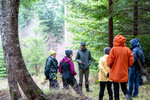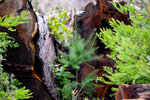

Nathan Daniel, executive director of GPC, explains that the organization's three pillars are conservation, stewardship and community engagement. While he acknowledged that today’s local development pressure keeps the lion’s share of GPC’s focus on conservation, acquiring land while it can still be had remains vital.
Filucy Bay Preserve continues to grow. An anonymous donor has given Great Peninsula Conservancy, the nonprofit land trust that owns the preserve, four parcels totaling 55 acres. The preserve now totals 170 acres.
While past additions focused on protecting the shoreline forests of Filucy Bay’s north cove, the new parcels extend the preserve across Mahncke Road into uplands to the east, with one arm reaching all the way to Pitt Passage. It includes 265 feet of undeveloped shoreline. There is currently no public access.
The preserve was created 10 years ago with a donation of 38 acres. In five phases of land acquisition since, it has grown through deals with willing sellers and donors. The preserve is known for its pristine shoreline along Filucy Bay, the diversity of its native forest plant community and the quality of its salmon habitat.
“We are always grateful and happy to work with conservation-minded land-owners willing to donate their ecologically valuable land to protect wildlife habitat forever,” said Nathan Daniel, executive director of GPC.
“This expansion of Filucy Bay Preserve will have a profound impact on the local ecosystem and allow GPC to make management choices that promote climate resiliency and help retain the rural character of the Key Peninsula.”
For neighbor Martha Konicek, the expansion represents a meaningful passageway between Filucy Bay and Pitt Passage for wildlife that is increasingly hemmed in by development.
The donated parcels vary in habitat quality. Roughly half the acreage is forested. Neighbor Maire Thornton has visited the woods since she was a girl growing up near Seattle. Her father George Thornton first bought property here in the 1960s and added to it several times, including several of the parcels that are now part of the preserve. He worked hard to manage it.
“He was adamant that he wanted it to remain forest,” she said.
Thornton remembered being pressed into service with her siblings by their father, who always had Scotch broom that needed to be pulled, alders to be cut and trails maintained, while their mother schemed excuses to return home early. He had a particular affinity for planting redwoods.
Of the remainder of the preserve’s new acreage, one 10-acre parcel was clearcut in 2021 by the donor to remove dying cedars and replace them with drought-tolerant firs and pines. Another 15-plus acres were clearcut around 2016 by previous owners and subsequently left untended, resulting in a dense thicket of Scotch broom and blackberry. Konicek called it the Scotch Broom Farm.
The clearcut areas underscore the challenge facing GPC, and any local conservationist, when presented with degraded land. As a land trust, GPC exists to hold land in perpetuity as a steward for the health of its ecosystems. The older clearcut was replanted with Douglas fir, but the baby trees lost out to the invasive species and the labor now required to restore it is daunting.
The more recent 10-acre clearcut was sprayed with an herbicide before it was replanted. Three years later it remains largely free of invasive species, though drought is a concern. Thornton said the soil in the area is outwash sand on top of glacial till. It does not hold water, and seedlings often struggle.
GPC’s three pillars are conservation, stewardship and community engagement, according to Daniel. While he acknowledged that today’s development pressure keeps the lion’s share of GPC’s focus on conservation, acquiring land while it can still be had, he said, “We’re putting a lot more energy into the property restoration and management than we used to be able to do.”
GPC stewardship manager Adrian Wolfe offered a recent example from the core of Filucy Bay Preserve. Last year GPC won a grant from the Washington State Recreation and Conservation Office for forest restoration. The organization used the funding to remove two giant patches of blackberry that had been the only blot in an otherwise intact forest of native species.
One patch was 5 acres; the other 1. “The blackberry was over your head,” Wolfe said.
“It had ten quadrillion berries,” Daniel added. “We don’t want it to be a seed bank. It spreads.”
GPC hired a local contractor to mow down the blackberries followed by a suppression spray. Last January the Washington Conservation Corps planted over 3,000 plants of 18 native species, including red cedar, hemlock, maple, alder, serviceberry, osoberry, Oregon grape, bald-hip rose and red-flowering currant. Wolfe said they’ll track which of them thrive.
Daniel said he knows that follow-up work will be required — the blackberries will come back — but he hopes that local volunteers can be involved who will find the work a way to connect with the preserve. “Cutting back 8-foot-tall blackberry is not a great volunteer opportunity,” he said. “It’s brutal. But pulling out little resprouts is more manageable.”
Over time, GPC plans to engage with local individuals and organizations who can become volunteer stewards for this preserve and others on the Key Peninsula. It hopes the work done this winter is a pilot for the restoration work that may happen on the new parcels, though any stewardship is dependent on the availability of funding and staff time.
Other items that may interest you
UNDERWRITTEN BY THE FUND FOR NONPROFIT NEWS (NEWSMATCH) AT THE MIAMI FOUNDATION, THE ANGEL GUILD, ADVERTISERS, DONORS AND PEOPLE WHO SUPPORT INDEPENDENT, NONPROFIT LOCAL NEWS
